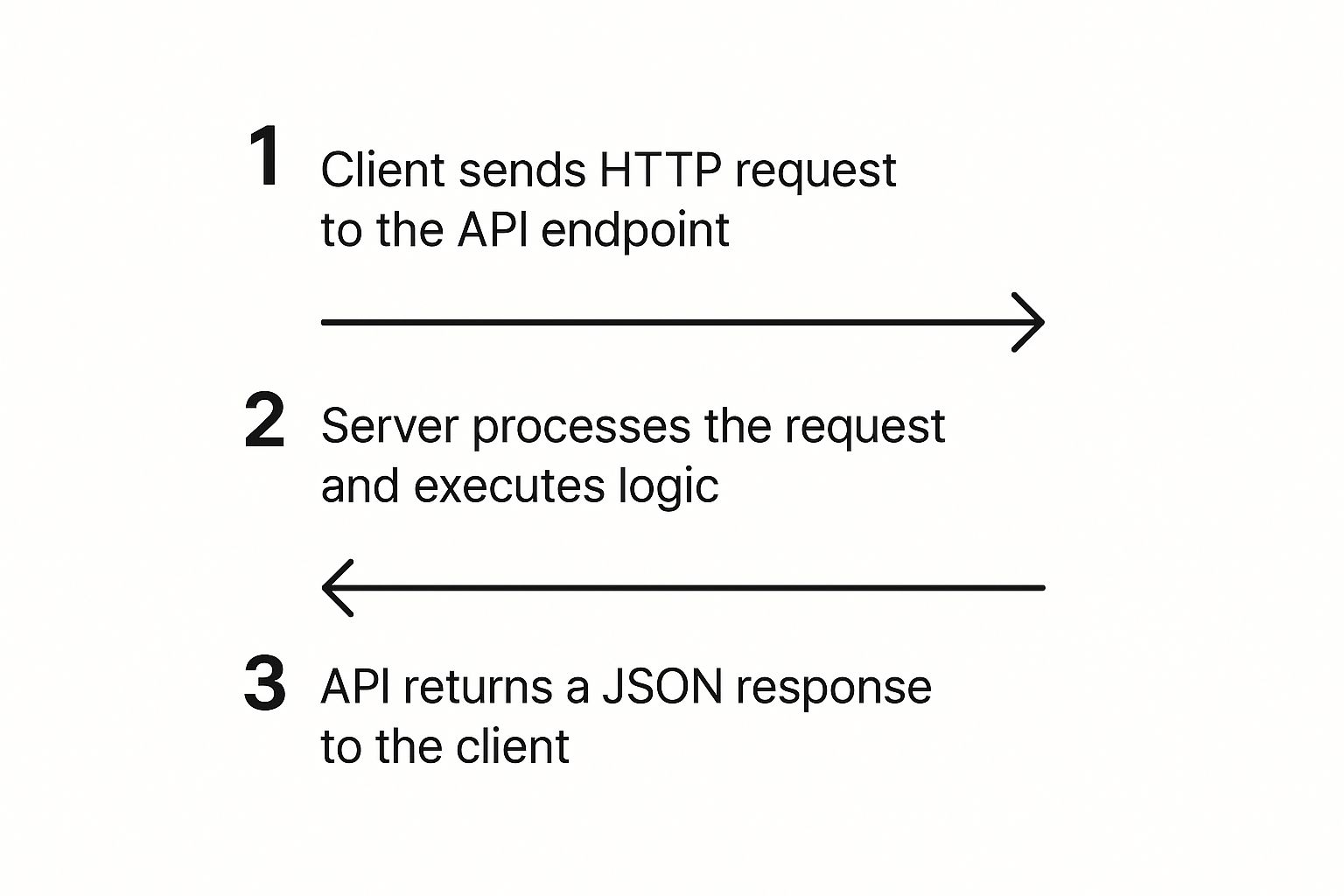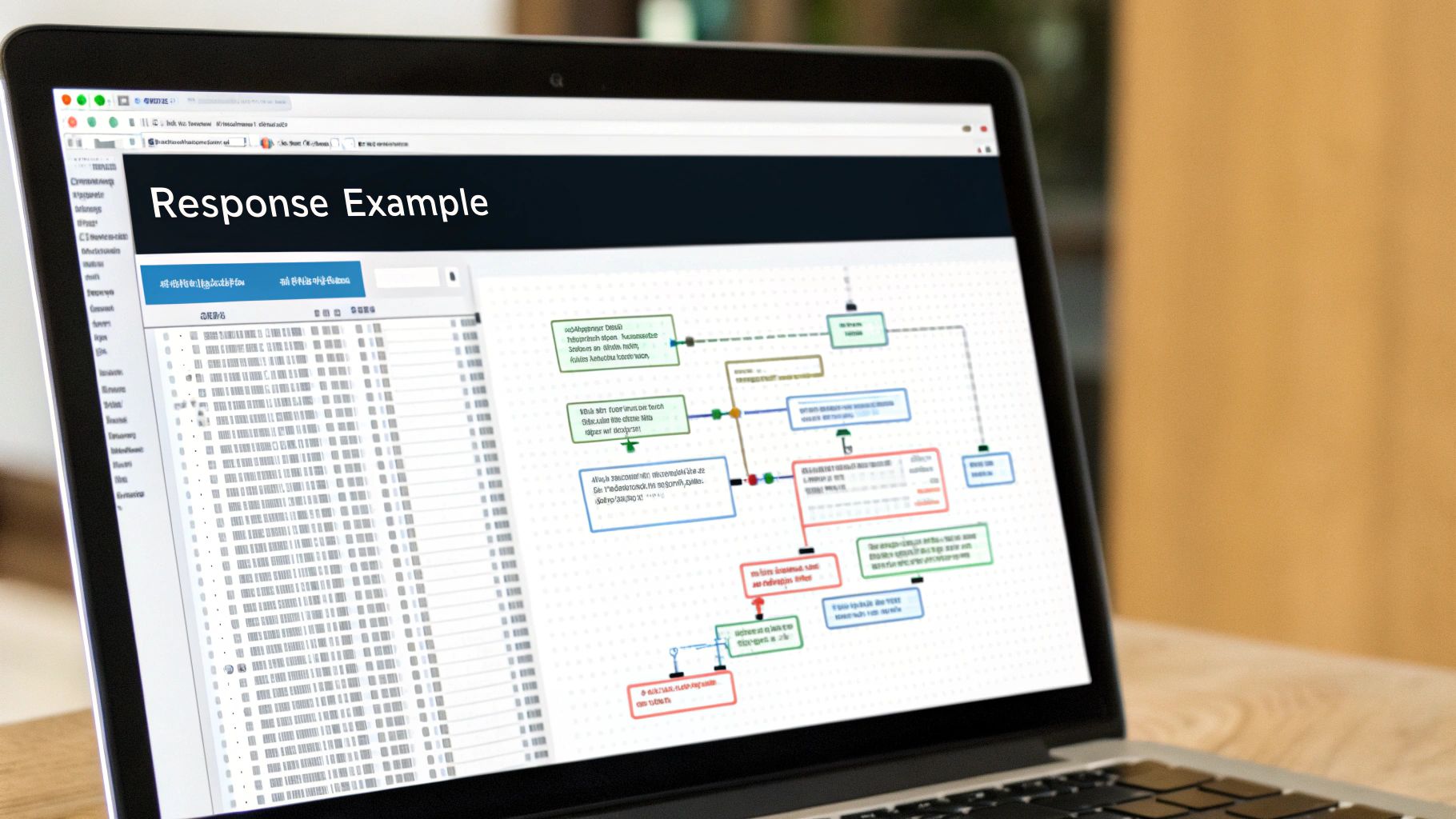Let’s start with the most important question: what exactly is an API endpoint?
Think of it like this: if an API is a restaurant menu listing all the available dishes, the endpoint is the specific waiter you call to your table to place an order. It's the exact digital address where one piece of software sends a request to get something specific back from another.
Your First Encounter with API Endpoints

To really drive that restaurant analogy home, an API (Application Programming Interface) lays out all the possible things a developer can ask for, just like that menu. But you can't just yell "I want food!" into the kitchen and expect results. You need a dedicated channel—the waiter—to take your order. That specific communication point is the endpoint.
Essentially, an API endpoint is the touchpoint where your application (the client) communicates with the server holding the data or functionality it needs. Every time you check the weather on your phone, see your Uber driver's location on a map, or refresh your Instagram feed, an API endpoint is doing the heavy lifting in the background.
The Anatomy of an Endpoint
An endpoint is simply a URL. But it’s not just any web address; each piece of that URL has a critical job. It guides your request to the right digital location to ask for precisely the right thing.
An API endpoint URL is like a precise mailing address for data. It tells the server exactly what you want and where to find it, ensuring there's no confusion in the request.
This is happening all the time in the apps you use daily. For example, a social media API uses different endpoints for every single action—one to schedule a post, another to pull user analytics, and a different one to fetch comments. Each task gets its own unique address.
To make this crystal clear, let's dissect what a typical endpoint URL looks like.
Anatomy of an API Endpoint URL
This table breaks down the different parts of a typical API endpoint URL to help visualize its structure and function.
| Component | Example | Purpose |
|---|---|---|
| Base URL | https://api.example.com | The root address for the entire API. |
| Path | /v1/users/ | Specifies the resource you want to access (e.g., users). |
| Parameter | ?id=123 | Filters or specifies the exact data you want to retrieve. |
As you can see, each part of the URL works together to form a highly specific instruction for the server, leaving no room for error.
How API Endpoints Bring Apps to Life
So, we've covered the "what," but how do API endpoints actually work in practice? Let's stick with the filing cabinet analogy. An endpoint is like a specific drawer in that cabinet, but you can't just yank it open. You need to tell the system what you want to do with the files inside.
These instructions are called HTTP methods, and they're the verbs of the API world. They tell the server precisely what action to take. It all happens in a simple, elegant dance: your app sends a request to the endpoint's address (its URL), the server does its thing, and then sends a response back.
This quick visual breaks down that back-and-forth conversation.

As you can see, the client application pings the endpoint, which kicks the server into action to fetch, create, or modify data before closing the loop.
The Most Common Commands You'll Use
Just like you can read, add, or toss out files, different HTTP methods let you perform different actions on a resource. Here are the four you'll see most often:
- GET: This is your read-only command. It fetches data from a server without changing a thing. Think of it as peeking inside a file.
- POST: This method creates something new. When you sign up for an account or publish a new blog post, you're likely using a POST request to add a new record to the database.
- PUT: Use this to update something that already exists. It’s like opening a file, making edits, and saving the new version over the old one.
- DELETE: Pretty self-explanatory—this one gets rid of a resource. It's the digital equivalent of tossing a file into the shredder.
For a deeper dive into how different applications use these principles to communicate automatically, check out this excellent Webhook Integration Guide. It's a great real-world example of endpoints in action.
Every time a server responds, it includes a status code. A 200 OK means your request was a success. A 404 Not Found means the server couldn't find what you were looking for. It's the server's simple way of saying, "Got it!" or "Sorry, that doesn't exist here."
This fundamental request-and-response system is the engine that powers our connected world, allowing totally different software systems to talk to each other seamlessly. It’s how your phone gets weather updates, how you log into websites with your Google account, and so much more.
Seeing API Endpoints in Your Daily Life

It might sound technical, but you're actually interacting with API endpoints all day, every day. They're the invisible workhorses behind the scenes, connecting the apps on your phone to the massive servers that store the information they need to function.
Think about the weather app you check every morning. When you open it, the app (the client) immediately sends a request to a specific digital address—an endpoint. This might look something like api.weather.com/v1/forecast?city=newyork. The weather service’s server gets that request, pulls the latest forecast for New York, and sends it right back to your screen. Simple as that.
Everyday Interactions Powered by Endpoints
This same pattern happens everywhere you look. The map in your ride-sharing app? It's not part of the app itself. Instead, it's being pulled in real-time from a service like Google Maps. Every time you book a trip or watch your driver's car move on the map, your app is hitting a specific API endpoint to get the freshest route and location data.
Here are a few more real-world examples of an API endpoint in action:
- Social Media: When you hit "like" on a photo, your app sends a quick message (a POST request) to an endpoint designed specifically to update that post's like count.
- Online Shopping: Dropping a new pair of shoes into your cart? That action sends a request to an endpoint that manages your shopping basket for that visit.
- Streaming Services: Searching for a movie sends your text to an endpoint that sifts through a gigantic library and returns a list of titles that match your query.
Each of these actions feels instant. But behind the curtain, a precise request is being sent to a designated API endpoint, which then returns exactly what the app needs to give you that seamless experience.
This constant communication shows just how much modern software has changed. Global API consumption has skyrocketed because companies now build and offer APIs as standalone products. They handle specialized tasks like payment processing or user logins, which other apps can then plug into.
This shift means that well-designed API endpoints are now absolutely critical for a reliable and user-friendly system. If you're interested in how this market is evolving, you can explore the latest API consumption trends on platformable.com.
Ultimately, these small, specific interactions are the very foundation of the modern internet. Each endpoint acts as a dedicated communication channel, allowing complex applications to talk to each other and deliver the rich, dynamic experiences we now take for granted.
Why Managing Your API Endpoints Matters
https://www.youtube.com/embed/_gQaygjm_hg
As a business scales, so does its technology. New features and services pop up constantly, and each one brings new API endpoints with it. Before you know it, you’re dealing with a sprawling web of digital touchpoints that can become a real headache to manage.
Without a solid plan, this complexity can quickly spiral out of control. You might start seeing unreliable services, glaring security holes, and a noticeable slowdown in how fast your teams can innovate. That’s why treating your APIs as core business assets—and managing them carefully—is no longer just an IT task. It's a strategic necessity.
The Role of API Management Platforms
Think of an API management platform as the air traffic control for your entire digital ecosystem. These tools give you a single, centralized dashboard to monitor every single endpoint. This is what empowers your teams to keep everything running smoothly and securely. For a deeper dive, learning about effective endpoint control is a great next step.
A strong management strategy isn't just about tidiness; it delivers tangible benefits:
- Traffic Monitoring: You get a crystal-clear view of which endpoints are being used, how frequently, and by who.
- Access Control: This is the foundation of good security. You can define exactly who gets to access specific data and services. To learn more, check out our guide on essential API security best practices.
- Performance Analysis: Easily spot bottlenecks and fix sluggish endpoints to keep your user experience top-notch.
The market's growth tells the same story. The API Management industry expanded to $8.94 billion in 2024 and is on track to reach a staggering $20.28 billion by 2030. This surge is fueled by the critical need to integrate endpoints reliably across increasingly complex systems.
Smart endpoint management directly impacts the bottom line by improving system reliability, creating new revenue streams through well-documented APIs, and empowering development teams to build new features faster and more securely.
Protecting Your Digital Front Door
Think of an API endpoint as the digital front door to your business. It’s the main entry point for data and functionality, so leaving it unprotected is like leaving your office unlocked overnight. Securing your endpoints isn't just a recommendation—it's absolutely critical for preventing unauthorized access and keeping your systems safe from abuse.
The first line of defense is authentication. This process simply answers the question, “Who are you?” Most of the time, this is done with API keys, which are unique strings of characters that function like a digital ID badge. When an application sends a request, it has to show its key. If the key is valid, the server knows the request is from a legitimate source.
But authentication is only half the battle. The next step is authorization, which asks, “Okay, you're in the building... but what are you allowed to do?”
An API key might let an app into the building (authentication), but authorization determines whether it can access the executive suite or just the mailroom.
Key Security Strategies
A solid security strategy needs multiple layers. Beyond simple keys, it's vital to implement more sophisticated methods to shield your digital assets from increasingly common threats.
- OAuth 2.0: This is a more advanced method than a simple key. Think of OAuth as a temporary, specific access pass given by the user. It lets an application perform actions on a user's behalf without ever handling their password, which dramatically lowers the risk of exposure.
- Rate Limiting: This is your bouncer. Rate limiting prevents any single user or application from overwhelming your system by setting a cap on how many requests they can make in a certain period.
- Input Validation: Always assume incoming data could be malicious. Input validation is the practice of inspecting every single request to make sure it's formatted correctly and doesn't contain harmful code, effectively stopping many common attacks in their tracks.
Our growing reliance on APIs has, unsurprisingly, made them a massive target for attackers. By 2024, the average enterprise was managing 613 API endpoints, and API traffic now accounts for over 71% of all dynamic web traffic. This huge footprint has led to a spike in attacks, with Account Takeover (ATO) attempts on endpoints jumping from 35% in 2022 to 46% in 2024. You can dive deeper into these trends in the Thales Group's 2025 application and API security report.
Frequently Asked Questions About API Endpoints

Even when you have a good handle on the basics, a few questions tend to pop up again and again. Let's clear up some of the common points of confusion to make sure your understanding is rock-solid.
What's the Real Difference Between an API and an Endpoint?
It's easy to get these two mixed up, but the distinction is pretty straightforward once you see it. Think of the API as the entire menu at a restaurant. It lists everything you can possibly order, the ingredients, and the rules for ordering (like no substitutions).
An endpoint, on the other hand, is like ordering a specific dish off that menu. It’s the single, direct action you take to get something specific, like telling the waiter, "I'll have the burger." The endpoint is the precise location—the URL—where one particular interaction happens.
In short, the API is the complete contract for communication. An endpoint is just one specific function, or "clause," within that contract. You need the API to give the endpoint its meaning.
Can One API Have Multiple Endpoints?
Not only can it, but it almost always does. In fact, a useful API needs multiple endpoints to be functional. A single API is built to manage a whole set of related tasks, and each of those tasks gets its own endpoint.
For instance, a simple project management API would likely have separate endpoints for different actions:
GET /projects/{projectID}/tasks— to retrieve all tasks for a specific project.POST /projects/{projectID}/tasks— to add a new task to that project.DELETE /tasks/{taskID}— to remove a specific task.
Each endpoint is a unique URL that performs a distinct job, but they all fall under the umbrella of the main project management API.
What Makes an Endpoint RESTful?
An endpoint gets the "RESTful" label when it's designed according to the principles of REST (Representational State Transfer). REST isn't a strict law you have to follow; it's more like a set of architectural best practices that make APIs predictable, scalable, and easier for developers to work with.
This comes down to using standard HTTP methods for their intended purpose (like using GET to retrieve data and POST to create it) and organizing URLs logically around resources (like /users or /products). For anyone building an API, sticking to these conventions is a hallmark of good design.
If you want to dive deeper into practical application, checking out some RESTful API best practices is a great next step.